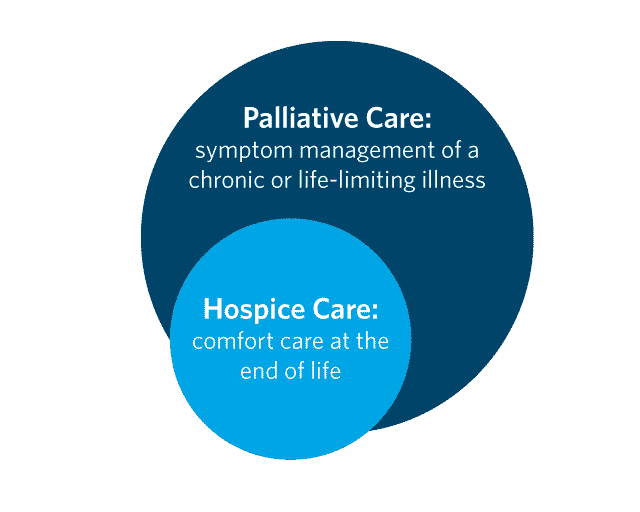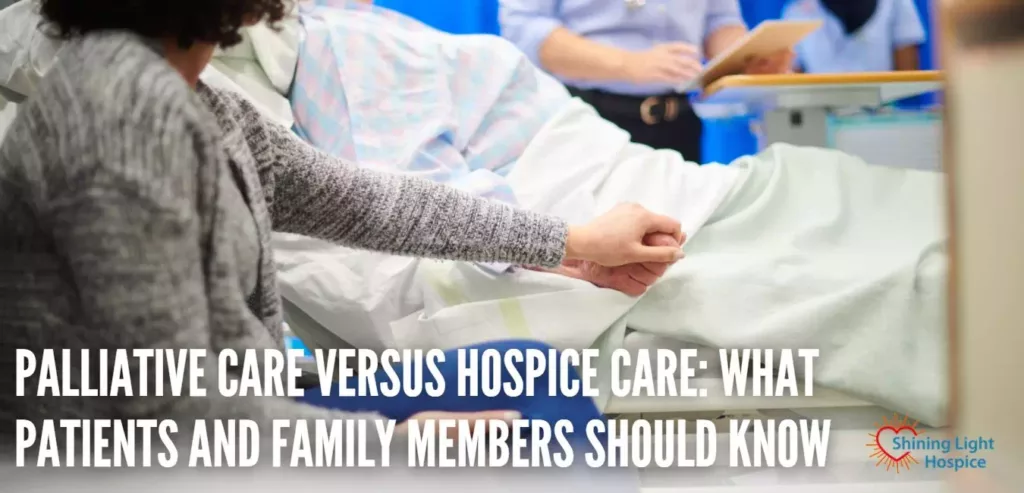Many people are puzzled about the difference between palliative care and hospice care. That’s understandable since they do share some commonalities. However, they’re ultimately very different types of care with dissimilar end goals. Patients and family members must be able to make informed decisions when it comes to the type of care provided, though, so we’re providing you with a definitive guide on palliative care versus hospice care to help make sure you’re able to understand the difference.

Common Areas
First, we’ll begin with the things that palliative care and hospice care have in common. Again, while they’re dramatically different treatments, they do have similarities in some areas. For instance, both of them are types of “comfort” care, in that they seek to make the patient as comfortable as possible.
Another similarity is that both palliative care and hospice care strive to reduce a patient’s stress and anxiety while offering solutions to symptoms. This can include pain management through medication, but also alternative therapies, physical therapy, occupational therapy, and more.
Finally, both hospice care and palliative care focus on addressing both physical discomfort, and providing psychosocial relief. This comes in many forms, including counseling, companionship, guidance and support solutions (for the patient and family members), and much more.
So, there are some pretty important similarities between these two types of care. Now it’s time to delve a little deeper into how they differ.
Palliative Care
In most instances, palliative care is paid for by private insurance, or by the individual. It can also be provided at any stage within the disease’s progress. During this type of care, patients can seek and receive curative treatments, and, often, palliative care is at least partially focused on addressing the side effects of those treatments.
Palliative care is usually provided within a hospital or in a clinical setting, but it can be provided within a private home, as well. With that being said, palliative care can be (and usually is) part of what is provided within the wider framework of hospice care. That’s because it’s comfort-focused.
Hospice Care
In contrast to the information above, hospice care can only be provided once a patient has become terminally ill and has six months or less to live. Patients receiving hospice care will not receive curative treatments, as the sole focus is on making them comfortable, improving their dignity, and improving their quality of life during the time that remains to them.
Hospice care is usually paid for by Medicare or Medicaid, or by private insurance, but rarely by the individual. Finally, hospice care is usually provided within a private home but may be provided in a long-term care facility, or even within a hospital in some situations.
Which Is Right for You?
Determining whether palliative care or hospice care is a better fit for your personal situation or that of a loved one can be pretty challenging. We’ve created a brief guide that will help you determine which path to take so you can make an informed decision.
- Do you still wish to pursue curative treatment for the disease?
If you decide to continue with curative treatments, including aggressive treatments or experimental options, hospice care is not the right option. Instead, consider palliative care to help improve your comfort during those treatments.
- Have you been diagnosed with a chronic illness? If so, has your condition become terminal due to the illness or an illness-related condition?
A diagnosis of aggressive or difficult to treat cancer is the primary cause of hospice care, but it not the only one. In some cases, patients dealing with liver disease, neurological diseases, diabetes-related conditions, and kidney disease also benefit from hospice care.
If you have been diagnosed with a chronic illness and your condition is now terminal, hospice care is likely the better path for you. Patients with terminal illnesses no longer seek curative therapies. Thus, your hospice care provider can focus on comfort, pain management, and providing the compassionate support required.
- Has your condition (or the condition of a loved one) declined significantly after a terminal diagnosis?
If this is the case, then hospice care can help. Compassionate caregivers offer help in many forms, from simple companionship to pain management and medication tracking.
Ultimately, it comes down to this – if your condition remains treatable, or you’re committed to pursuing any form of cure, then palliative care is the better option. If you have exhausted your options and want to spend your remaining time in hope, freedom, and dignity, then hospice care is the right choice.
A Caring Touch
With the right hospice care provider, terminal patients can spend their remaining time free of pain, and in good spirits. Our team of compassionate professionals can work with you to create a customized hospice plan, provide planning and guidance, counseling, and much more.






